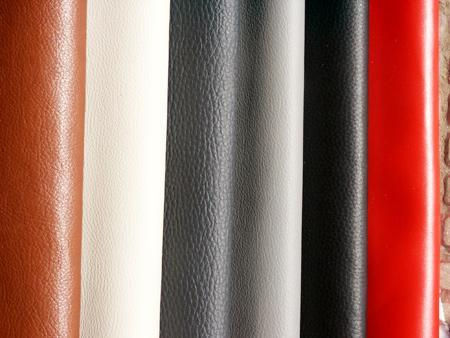How to Choose the Right PVC Leather Roll for Your Project
- rockuniquotersseo
- May 13
- 4 min read
PVC leather, also known as synthetic leather or vinyl leather, has become a go-to material in a wide range of industries—from upholstery and automotive interiors to fashion accessories and home décor. Durable, water-resistant, and cost-effective, PVC leather offers a smart alternative to genuine leather, especially when budget, ease of maintenance, and versatility are key. But with so many types, finishes, and grades available, how do you choose the right PVC leather roll for your project?
This guide breaks down the critical factors to consider so you can make a smart, informed decision and avoid costly mistakes.
1. Understand Your Project Requirements
Before diving into material specs, you need a clear understanding of what your project demands. Ask yourself:
Will the PVC leather be used indoors or outdoors?
Does it need to withstand wear and tear, moisture, or UV rays?
Will it be stretched, glued, or stitched?
What kind of texture and color are needed to match your design goals?
For example, a PVC leather roll intended for a car seat cover needs far more durability and heat resistance than one used to wrap a decorative panel.
2. Know the Grades and Backing Types
PVC leather comes in various grades that reflect thickness, flexibility, and backing quality. The backing is the foundation of the material—it gives the leather structure, strength, and support. Common backing types include:
Woven polyester: Good for upholstery and general use.
Non-woven fabric: Often used where a smoother, thinner look is needed.
Foam-backed: Offers extra cushioning, ideal for automotive or furniture projects.
Higher-end rolls often come from a trusted leather manufacturer that discloses detailed specs like backing type, thickness, and intended applications. Don’t settle for vague product descriptions. When in doubt, request samples.
3. Assess Durability and Performance
Durability isn’t just about how thick the PVC leather is. It’s also about how the surface coating is constructed. Look at these performance indicators:
Abrasion resistance: Measured by Martindale or Wyzenbeek rub tests. The higher the number, the more durable it is.
Tear strength: Important for stretched applications like furniture or car seats.
UV resistance: Critical for outdoor use or anything exposed to sunlight.
Cold crack resistance: For products used in colder climates—especially in the automotive and marine industries.
Choosing a roll from the Best Leather Company usually ensures the product has been tested for these qualities. That extra layer of quality assurance is worth the investment.
4. Check for Compliance and Safety Standards
If your project involves consumer goods, furniture, or vehicle interiors, you may need to meet safety and regulatory requirements. Look for PVC leather rolls that comply with:
REACH and RoHS: European standards limiting harmful chemicals.
California Proposition 65: Important for products sold in the U.S.
FMVSS 302: A flammability standard for vehicle interiors.
You’d be surprised how many off-brand suppliers skip these certifications. Always ask for test reports or compliance documentation—especially for commercial or large-scale projects.
5. Texture, Finish, and Appearance
PVC leather is available in a huge range of textures—from smooth and glossy to pebbled, embossed, or matte. Consider:
Grain type: Fine or coarse textures can dramatically change the look.
Finish: Matte, semi-gloss, or high-gloss depending on your design.
Embossing: Crocodile, snake, ostrich, or custom patterns.
Try to get physical swatches whenever possible. Photos online rarely capture the exact feel and appearance. For interior design or fashion projects, the right texture can be the difference between cheap and premium.
6. Color Matching and Customization
Need a specific Pantone shade or want to match an existing product line? Some suppliers—especially a reputable leather manufacturer—offer color-matching services. You send them a fabric or color sample, and they produce a custom PVC leather roll to match.
Customization options can include:
Custom colors
Branding embossments
Special coatings (anti-bacterial, flame retardant, etc.)
These services usually have minimum order quantities, so they’re ideal for brands, designers, and manufacturers.
7. Consider Environmental Impact
While PVC isn’t known for being the most eco-friendly material, some companies now offer more sustainable options. Look for:
Phthalate-free: Safer for both people and the planet.
Low-VOC emissions: Reduces off-gassing indoors.
Recycled content: Some PVC leather rolls use recycled backing or vinyl.
This matters more than ever to consumers. If your audience values sustainability, it’s worth sourcing from a supplier that can verify these claims.
8. Evaluate Cost vs. Value
PVC leather is often chosen for its affordability compared to real leather—but don’t let price alone guide your decision. A cheap roll may cost more in the long run if it cracks, fades, or stretches too easily.
Instead, think of value: what are you getting for the price? Compare warranties, testing certifications, and sample reviews. The Best Leather Company isn’t just about name recognition—they usually deliver better consistency, support, and longevity.
9. Order Samples Before Bulk Purchase
This might be the most important tip: always test before committing. A sample gives you firsthand insight into:
Feel and pliability
Stitching or gluing behavior
Compatibility with your tools and machines
True color in real light
Many suppliers will send free or low-cost samples. Don’t skip this step—especially if your project depends on appearance or performance.
10. Choose the Right Supplier
Finally, where you get your PVC leather roll matters. Look for a supplier with:
A wide selection of in-stock options
Clear technical specifications
Fast, reliable customer service
Industry reputation and reviews
If you’re sourcing regularly, try to establish a relationship with a consistent supplier. It saves time, ensures better quality control, and often gives you access to custom solutions.
Final Thoughts
Choosing the right PVC leather roll is more than picking a color and clicking “Buy Now.” It’s about aligning material specs with the real-world demands of your project—whether that’s a rugged truck seat, a sleek handbag, or a designer wall panel. When in doubt, trust the specs, ask for samples, and buy from a leather manufacturer or brand with a solid track record.



Comments